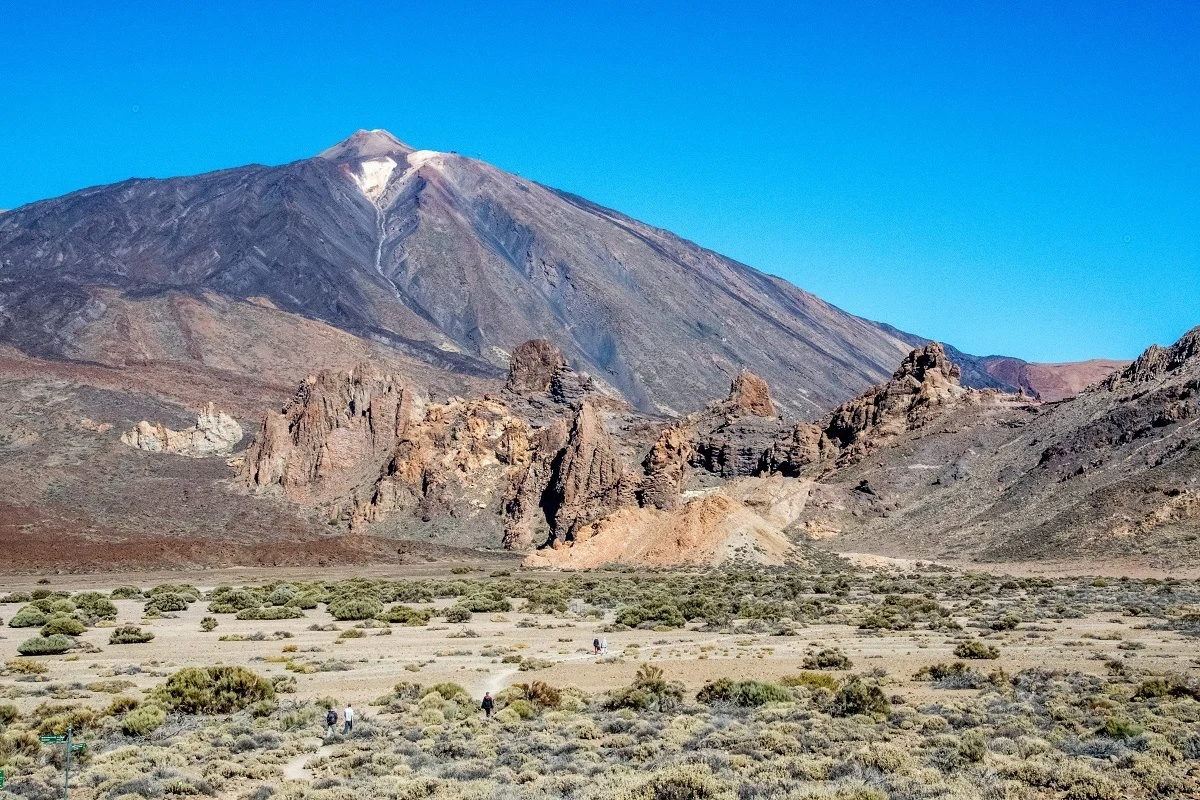
No visit to the Canary Islands would be complete without visiting the Mount Teide volcano, Spain’s highest mountain. This imposing volcano is the reason for the island’s existence and casts a huge shadow over the entire island. But those who visit Mount Teide will be rewarded with incredible views from the summit!
Given the number of tourists who come to Tenerife every year, it’s no surprise that Mount Teide National Park is the most visited national park in Spain and also in all of Europe. Millions of visitors come to this barren landscape every year for the incredible views.
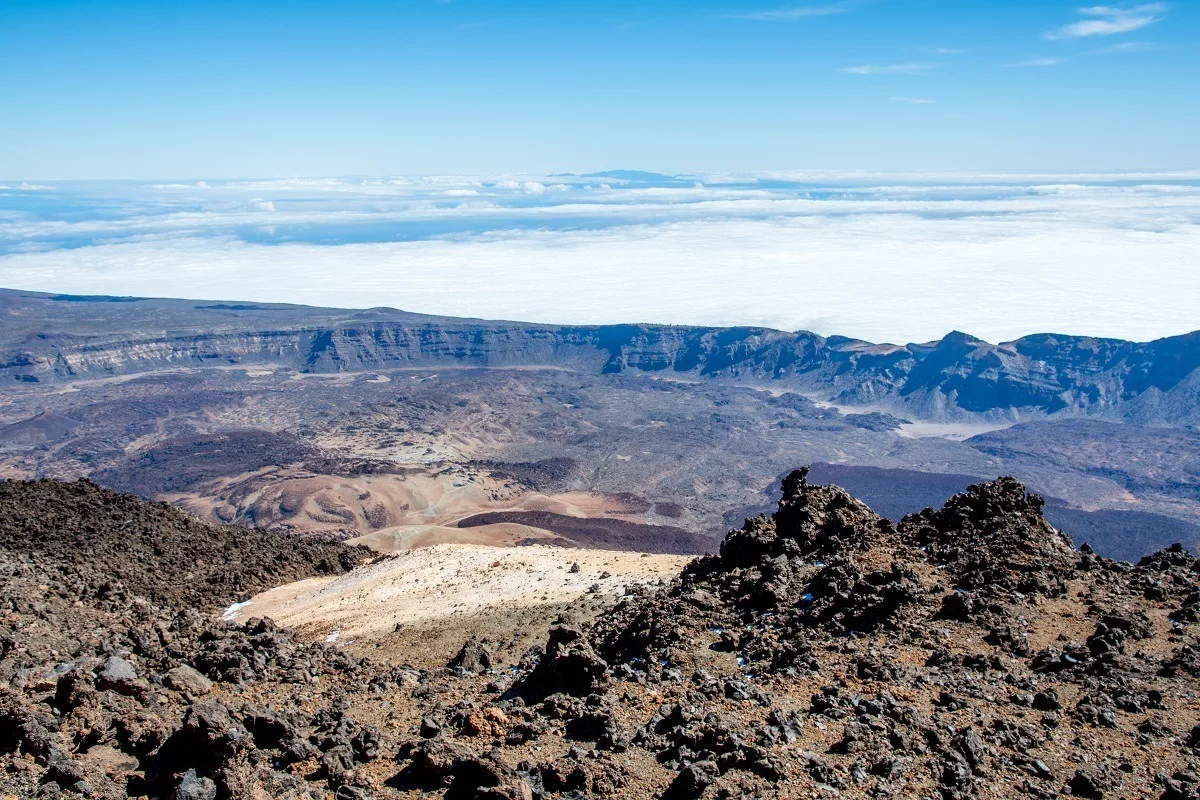
Like most visitors to the Canary Islands, we knew we wanted to visit the Mt Teide volcano during our brief holiday in Tenerife. We found lots of contradictory information on the Internet on the best way to go about it, so we set out to write this ultimate guide to Mount Teide to help other visitors.
Our day-long, self-guided Tenerife volcano tour was the highlight of our trip! However, there are many ways to see and enjoy the volcano.
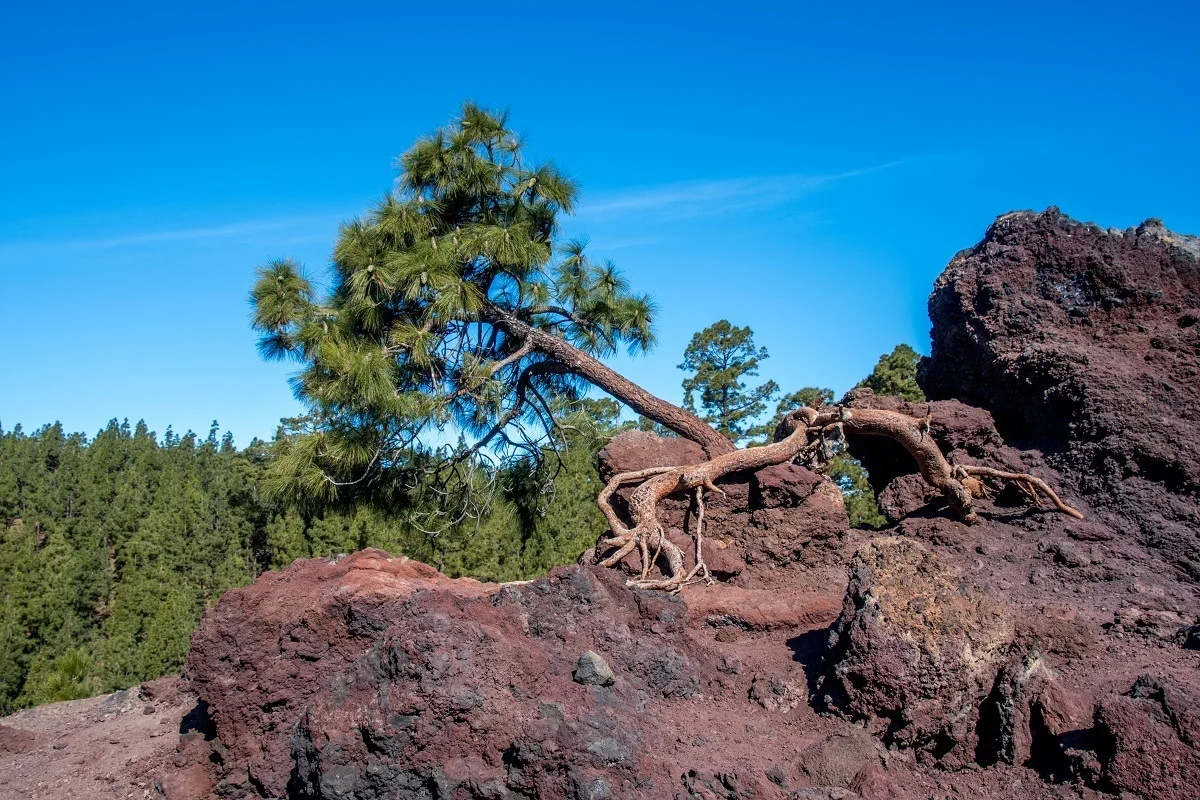
- Visiting Mount Teide
- Mount Teide Excursions and Tours
- Driving Mount Teide in a Rental Car
- Climbing Mount Teide
- Cycling Mount Teide
- Things to Do in Mount Teide National Park
- The Mount Teide Cable Car
- Mount Teide Summit Climb
- Mount Teide Hikes
- Mount Teide Stargazing
- Mount Teide Observatory
- Photographing the Volcano
- Visiting a Winery
- Top Tips for Visiting
- Book Your Mount Teide Cable Car Tickets in Advance
- Mount Teide Summit Permit
- Mount Teide Parking
- Mobile Phone Service
- Where to Stay While Visiting Mount Teide
- Where to Eat on Mount Teide
- Restaurante Papillon
- Restaurante La Bamby and Restaurant el Portillo
- Restaurante Parador de Las Cañadas del Teide
- Cable Car Snack Kiosk and Buffet
- What to Bring on Your Trip
- Frequently Asked Questions
Visiting Mount Teide
There are a number of ways to get up the volcano on Tenerife. Here are your Mount Teide travel options, listed in order of least to most strenuous:
Mount Teide Excursions and Tours
There are numerous Mount Teide tours and excursions that will drive you and direct you to the highlights within the national park. Please note, not all of the excursion packages allow enough time to take the cable car to the summit. Where the cable car is included, we’ve noted it. Otherwise, assume this is a driving-only excursion that just takes you through the park.
Here are some of the most popular Mount Teide tour options:
- From Playa de las Americas by private jeep, which includes Masca
- From Puerto de la Cruz: National Park VIP Tour
- Tenerife: 5-Hour National Park Jeep Safari. This is one of the few Mount Teide trips from Costa Adeje and other points in the southern part of the island.
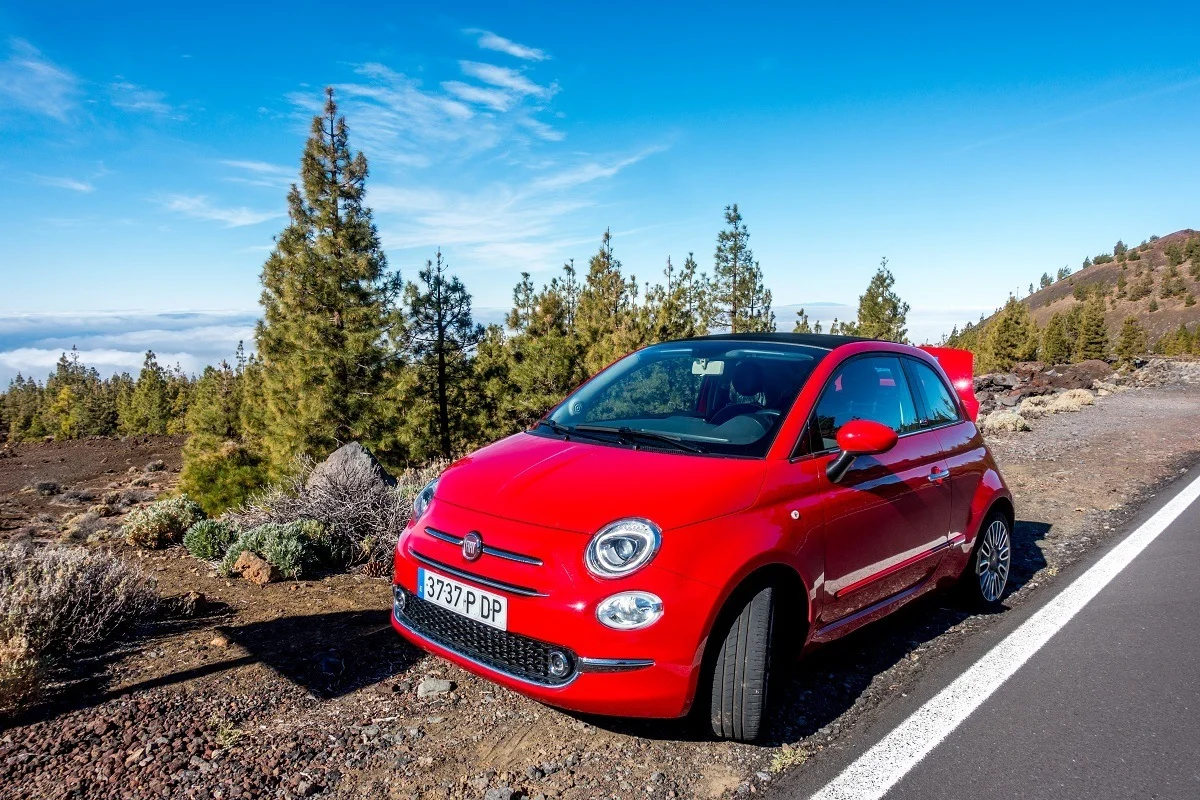
Driving Mount Teide in a Rental Car
The best and most rewarding option is to rent a car and drive Mount Teide yourself! This gives you maximum flexibility and is also more economical than an excursion or package tour. We recommend renting a car at the airport and having it for your entire stay.
There are three main approaches to the volcano. Leaving from Puerto de la Cruz in the north, from Los Christianos in the south, and from Los Gigantes in the west. Assume you are staying anywhere in Southern Tenerife (Costa Adaje, Playa de las Americas, etc.), we recommend driving up from Los Gigantes in the morning. There are fewer cars than along the other routes. In the afternoon, we recommend driving back through Vilaflor and Los Christianos, which allows you to stop at the winery in the afternoon.
While the national park is well signposted, given the poor mobile phone reception, you might want a quality driving map of Tenerife.
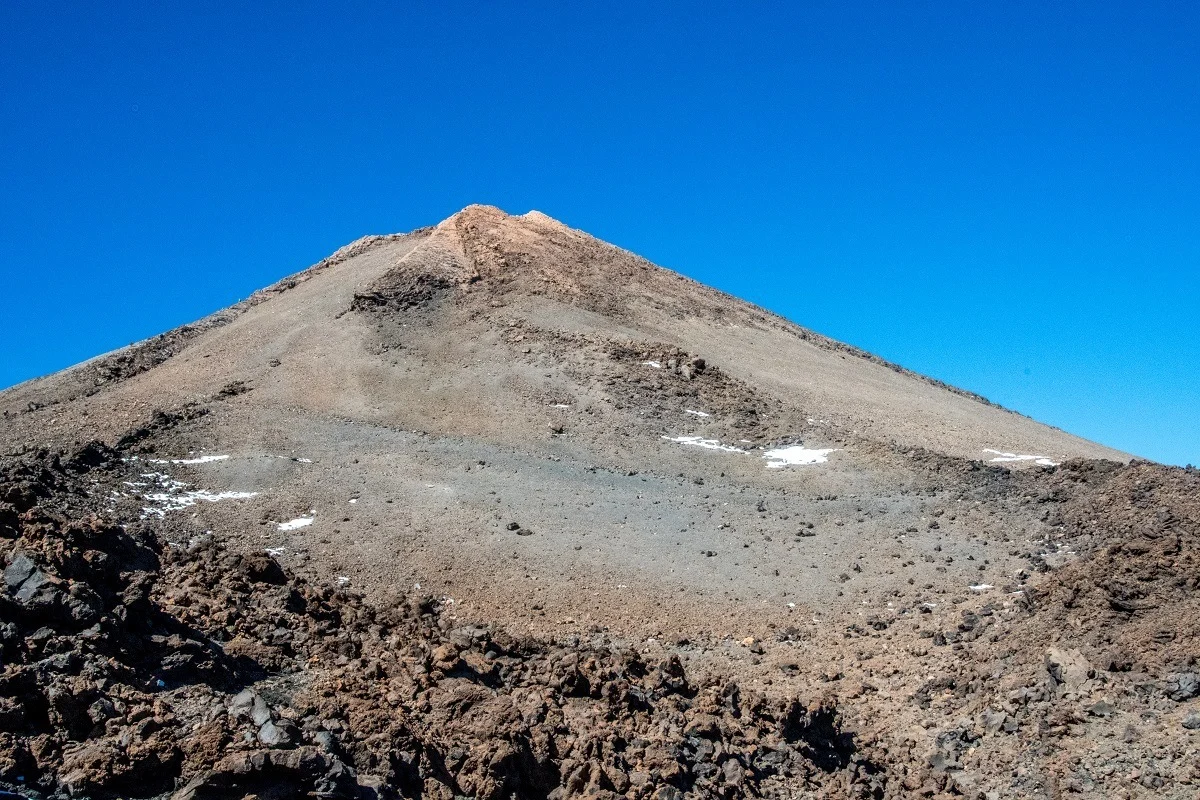
Climbing Mount Teide
When people speak about the “Mount Teide climb” they are usually only talking about summiting the mountain from the cable car or the more popular Montaña Blanca route. But that’s not really climbing Teide.
The die hard hikers and mountaineers who visit actually climb the volcano from sea level. That means hiking all 3,718 meters (12,198 feet) up to the highest point in Spain. This is not for the recreational hiker!
There are two routes: the Playa de El Socorro and the Camino de Chasna. The Playa de El Socorro starts at the beach bearing that name on the north shore. This is the shorter (and steeper) of the two routes. It generally follows back roads and steep trail up into the Teide National Park, where it intersects the main trail just above Montaña Blanca.
The second route is the Camino de Chasna. This route follows the Camino Real from Puerto de la Cruz to La Orotava, and then the Camino de Chasna from La Orotava up to the Portillo in Teide Park. The route was popularized by the naturalist Alexander von Humboldt over 220 years ago. It’s sometimes called the Humboldt Pilgrimage.
Anyone considering either hike should get specialized topographical maps for Tenerife and plan their route carefully. Again, this is not an easy hike and should not be undertaken casually.
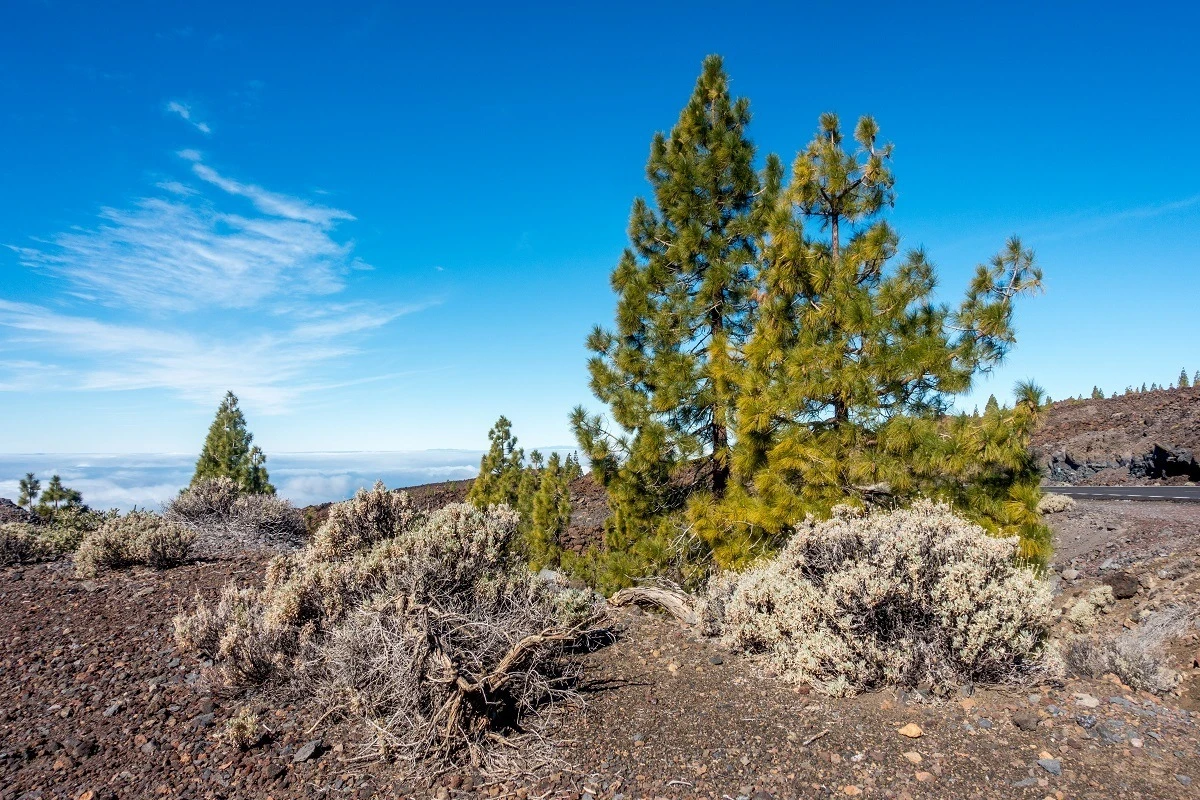
Cycling Mount Teide
Every winter, professional cyclists from around the world descend on Tenerife for training. For amateur cyclists, the chance to do it like the pros and ride up the volcano in Tenerife can be extremely compelling. Although it probably shouldn’t be attempted unless in excellent physical shape.
For cyclists (and runners) training, Spain’s highest mountain represents both a challenge and opportunity: extreme climbing. The Mount Teide road is one of the longest continual ascents in the world, and the longest in Europe. It is a chance to climb directly from sea level up to one of the tallest volcanoes in the world.
There are three popular routes up the volcano, but the most popular leaves from Los Christianos in the south. This is the steepest and shortest way up the mountain, but also has a few towns and villages along the way in case something should go wrong. There are also trees for the first half of the trip, which can provide shade.
The second route leaves from Puerto de la Cruz and basically fallows the Camino de Chasna. Over half the trip is spent riding past lush vegetation. This is the longest of the three routes up the volcano, but is the least steep (although there are some sections with serious grades).
The third and final route leaves from Los Gigantes on the western end of Tenerife. This route has the least traffic and some of the prettiest landscapes on the entire volcano. Cooling mists on the volcano’s western end are not uncommon.
Visitors who want to test themselves against the mountain now have the chance. One company runs Friday cycling trips up El Teide. They follow the Los Christianos to Vilaflor route – the shortest and steepest. If you want to test your skills, consider booking this cycling ascent of the mountain.
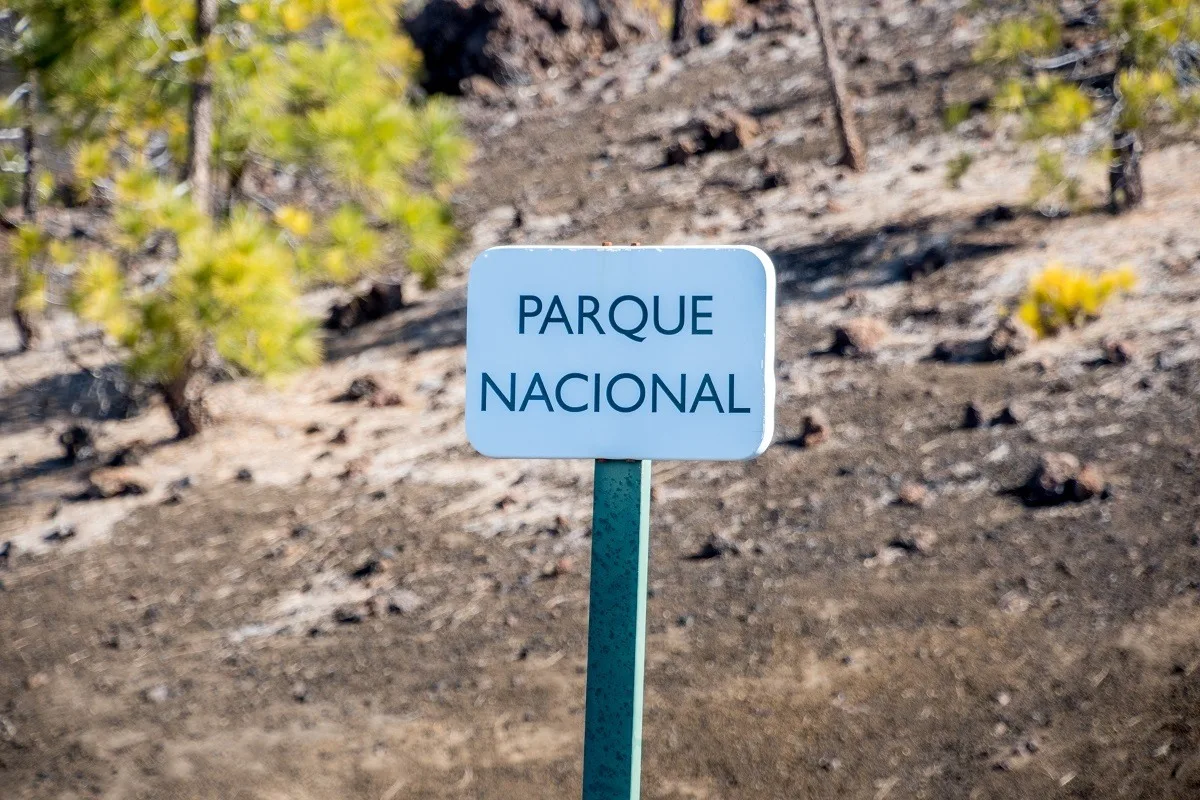
Things to Do in Mount Teide National Park
The Mount Teide Cable Car
The Mount Teide Cable Car is the top Tenerife attraction and the most popular activity in the national park. The cable car whisks visitors 1,199 meters up the mountain in speed and comfort.
The cable car takes just 8 minutes to make the ascent while taking 44 passengers at a time. The cable car never gets more than about 30 meters above the side of the mountain, so it is perfect for people who have a fear of heights because it never gets very high.
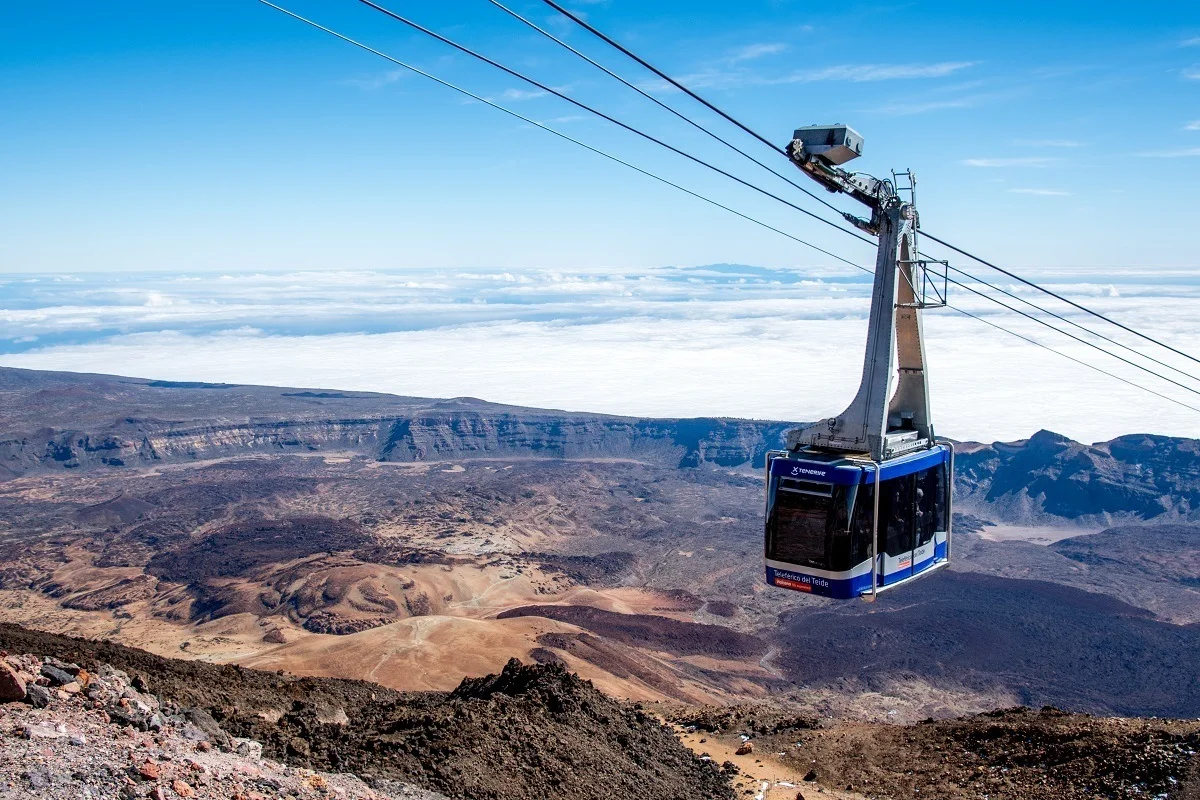
Visitors need a special permit to hike from the upper cable car station to the volcano summit. However, if you don’t have a permit, there are two other good trails to hike near the summit. Trail Number 11 goes to the La Fortaleza Vantage Point for views of Northern Tenerife. Trail Number 12 goes to the Pico Viejo Vantage Point for views of Southern Tenerife and the volcano caldera of Las Cañadas del Teide.
The best way to take the cable car is to pre-book Mount Teide tickets here (for cable car only) or tickets for the cable car, including summit hiking permit. Remember, you should be at the lower cable car station 20 minutes prior to your ticket time. Parking can be difficult, so be sure to see our parking tips below.
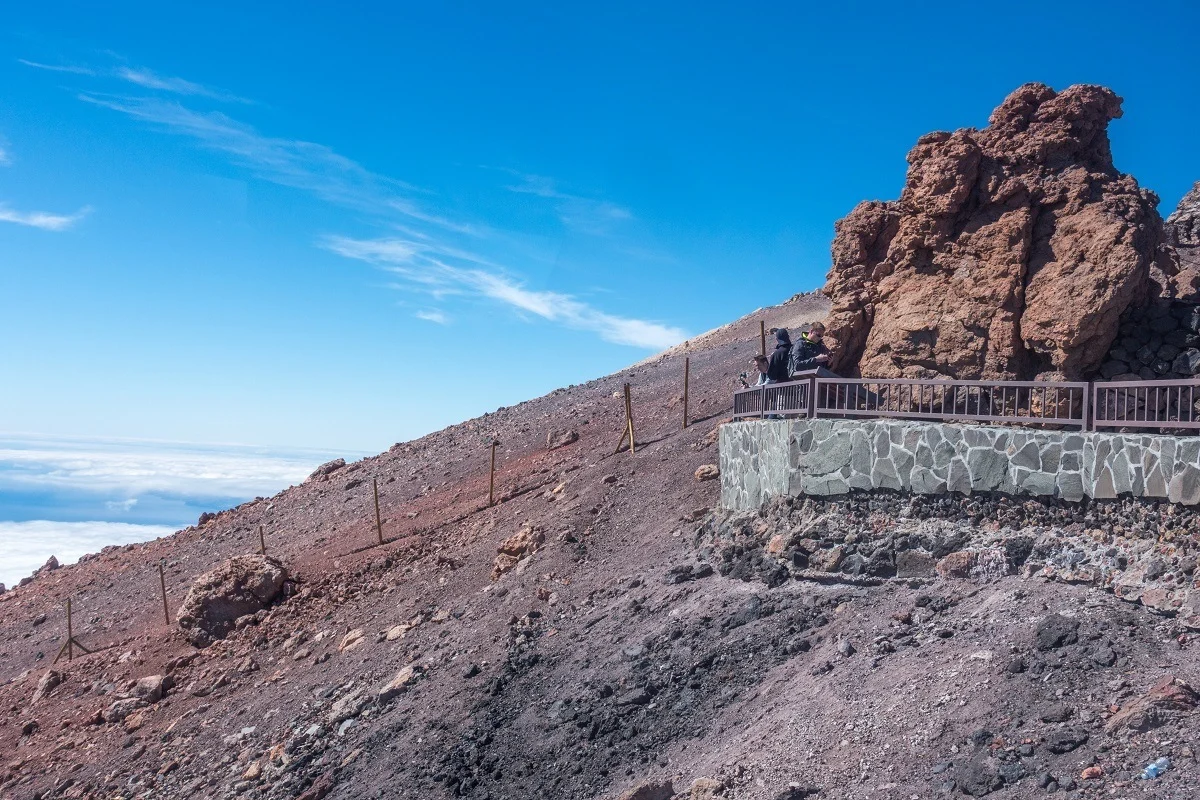
Mount Teide Summit Climb
There are two ways to reach the summit.
First, most summit hikers do the two-day trip from Montaña Blanca. This trip is divided into three stages. On day 1, complete stage 1 by hiking the Montaña Blanca trail to the Altavista Refuge. From the main road in national park (TF-21 Teide Road), head to the Montaña Blanca trailhead (located at approximately kilometer 40.5 between the lower cable car station and Portillo). On the north side of the road there is a small car park to leave your vehicle. Be sure to sign the hikers log before beginning your trip.
Follow the Montaña Blanca Trail up the mountain (trail number 7). The trailhead is located at 2,348 meters and your goal is the Altavista Refuge at 3,260, where you can spend the night. The route will take you 4.5 kilometers up to the summit of Montaña Blanca, before climbing another 2.6 kilometers up to the Altavista Refuge (this section is EXTREMELY steep). Most hikers will complete this journey in around 5-6 hours. (Both of the hikes from sea level mentioned above intersect the Number 7 Montaña Blanca Trail.)
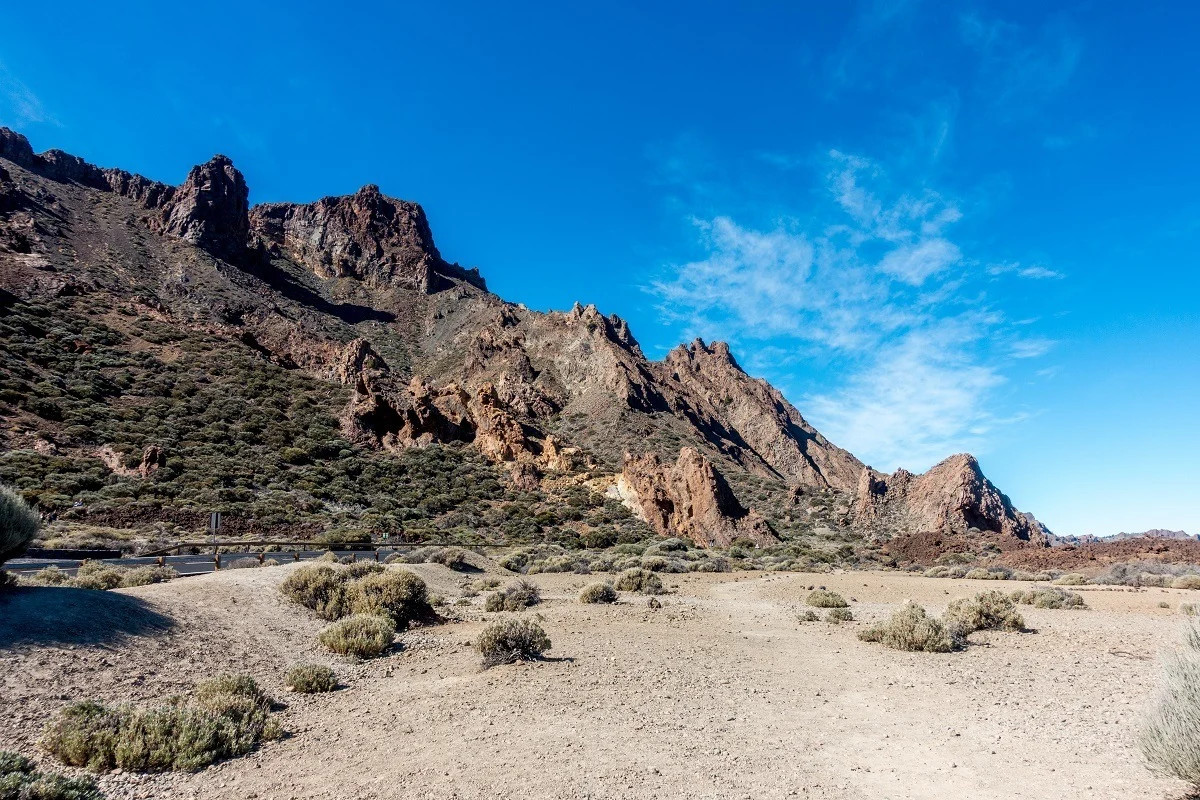
Sleep overnight at the Altavista Refuge (detailed information on the refuge is below). Remember you need to bring your own food and water. This is basic accommodation (a bunk bed). However, by sleeping at the Altavista Refuge, your summit permit is included (if you are off the summit by 9:00am). You will be one of the lucky few to experience a Mount Teide sunrise.
On day 2, you will get up extremely early (like between 4:00-5:00am) to complete the second stage. After leaving Altavista Refuge, hike the ~1km to La Rambleta cable car station. In the dark, this usually takes most hikers about an hour.
From there, immediately begin stage three (which is the same as if you took the cable car):
The second way to hike the summit is to take the Teide National Park Cable Car to the the upper station, which is called La Rambleta (and this is the third stage if you are hiking the Montaña Blanca trail). This is located at 3,555 and is just below the summit (3,718 meters), the highest point in Spain. That last 163 meters may not seem like much, but it can be a real struggle when you are at extreme elevation and struggling for breath. You’ll slowly make your way up the mountain and past numerous sulfur vents while en route to the summit.
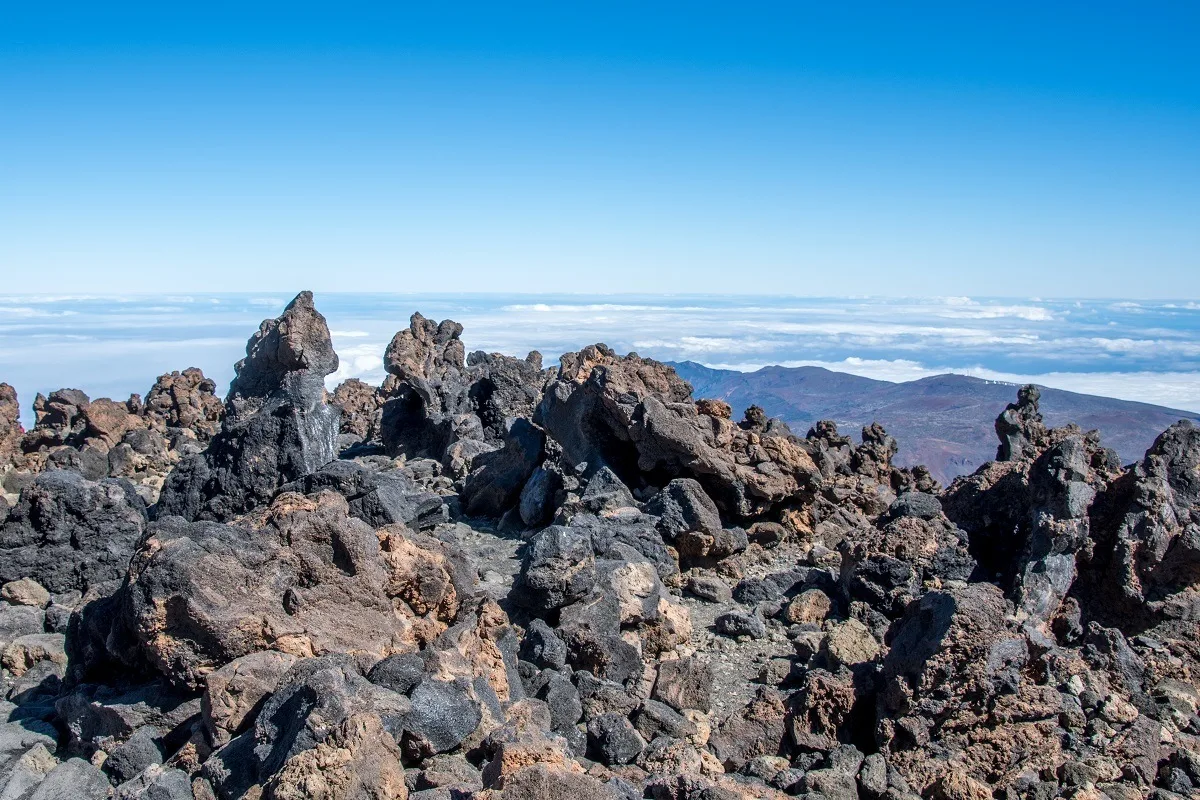
To reach the summit, follow the Telesforo Bravo trail (trail 10) up the mountain. Some hikers are able to make the climb in about 20 minutes, while other people can take over an hour. Whatever your level of fitness, take your time and watch your footing. Loose rocks can be found on the path.
If you want to do the hike from the cable car (and did not sleep at the Altavista Refuge), remember that a permit is required and only 200 permits are issued per day. Request your permit as far in advance as possible! Permit requests can be submitted here. An alternative is to book the guided cable car tour, which includes the permit. Book the cable car guided tour with summit permit here.
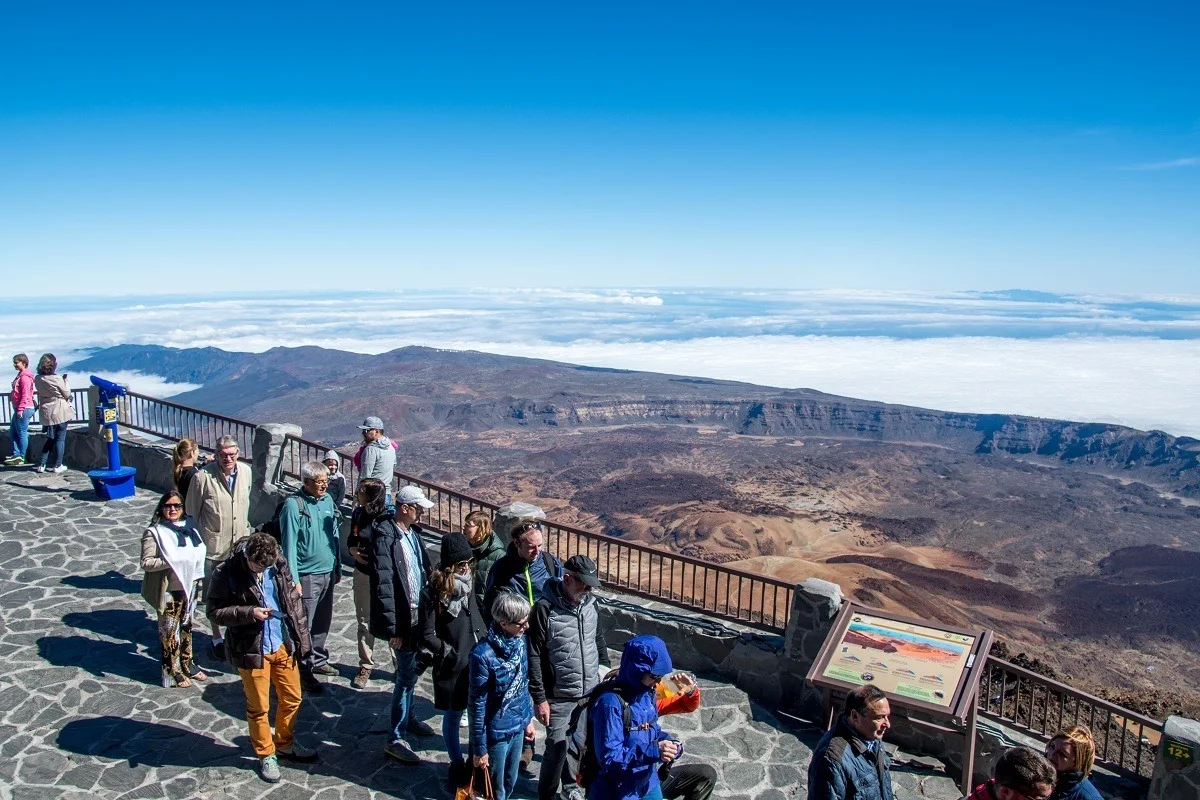
Finally, remember after making the summit, you need to get down! You can either hike all the way back down the way you came. Or, you can buy a ticket for the cable car and go back that way.
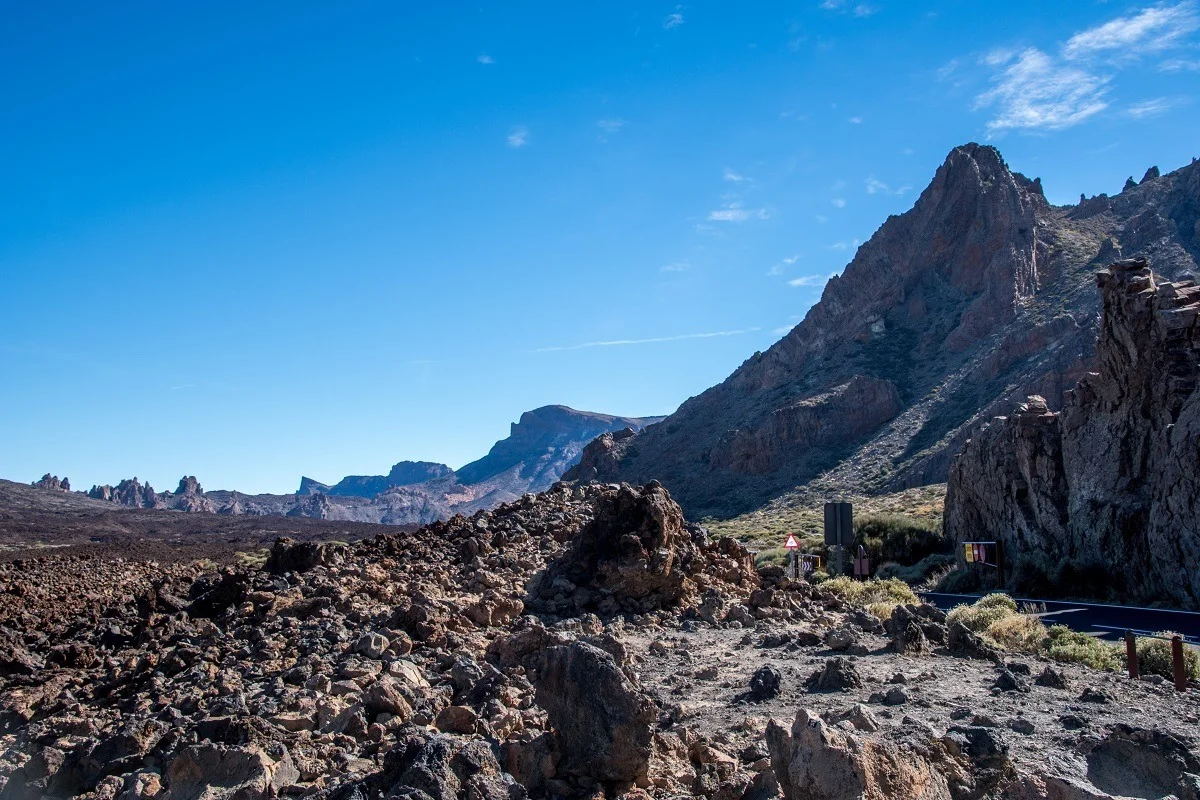
Mount Teide Hikes
There are so many more Mount Teide hike options than just number 10 to the summit and number 7 up Montana Blanca. In fact, there are 37 officially designated trail options in the park (many with views of the volcano) covering nearly 400 kilometers of ground.
Since nearly everyone who visits the national park focuses on the volcano cone and the summit, if you decide to hike in the park, you’ll likely have the trail all to yourself!
Mount Teide Stargazing
As popular as the summit and cable care are, stargazing on the volcano may be even more so. Since Tenerife and the Canary Islands are so isolated, it is the perfect location for stargazing! Seeing the stars on Mount Teide is made easier because of the lack of light pollution from area areas and the national park being located well above the marine layer (clouds formed by thermal inversion near the ocean). From the volcano, you can see 83 of 88 constellations with tremendous clarity.
Guided stargazing tours bring visitors up to the national park to look through special telescopes. It is completely different way to enjoy the beauty of the national park. Book stargazing tours of Mount Teide at night here.
Note: If you are self-driving, please be extremely careful descending the mountain in the dark. There are no road lights and many of the turns are extremely tight. Auto accidents are a frequent occurrence at night!
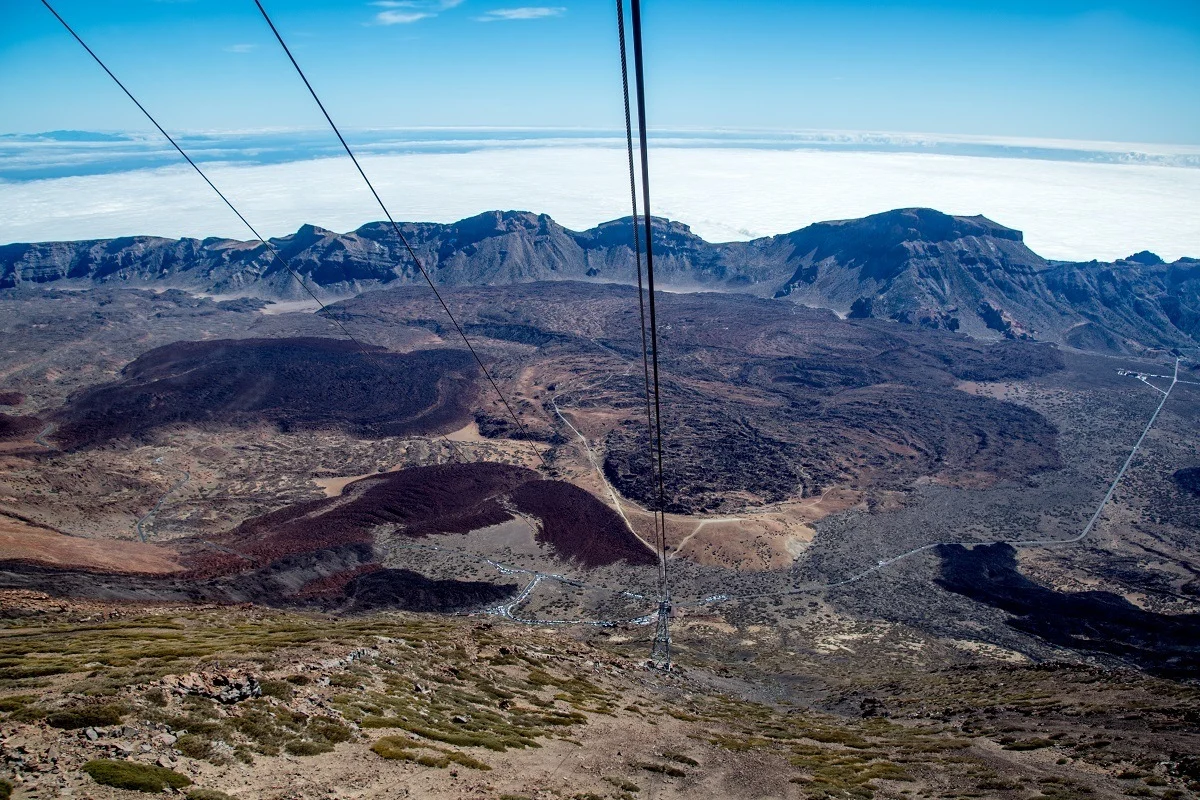
Mount Teide Observatory
The Teide Observatory is the largest solar observatory in the world. It is possible to visit the observatory on a pre-booked daytime tour (this is a solar observatory). You won’t have access to any of the research telescopes, but they have special telescopes for visitors who can observe the sun. Tour space is limited and it is extremely popular, so if the observatory in Tenerife is on your bucketlist, be sure to book your tour early.
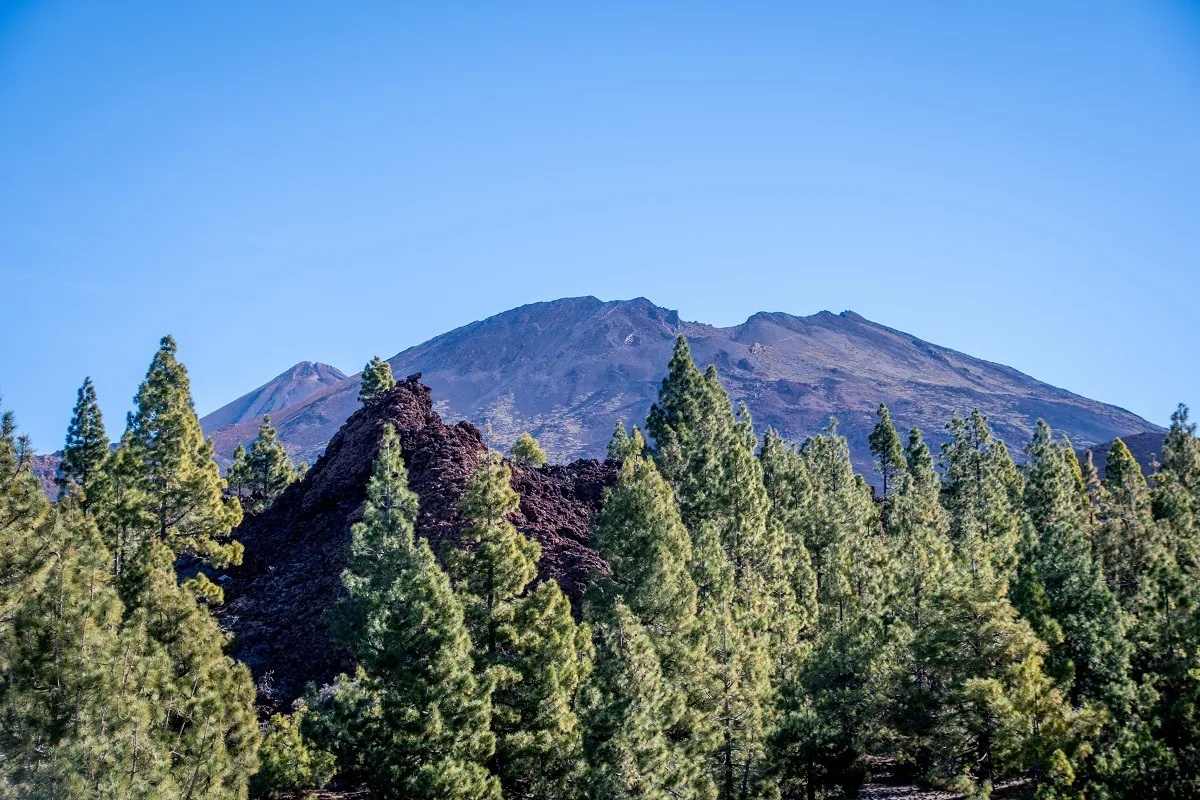
Photographing the Volcano
Throughout the national park, you’ll see tourists with cameras pointed up at the volcano cone of Mount Teide. One of the most popular things to do in the national park is to photograph the volcano itself. And why not? It’s incredibly photogenic!
Here are some of our favorite viewpoints:
- Los Poleos: On the west side of Tenerife driving up Teide along TF-38. This is your first good view of the cone rising above the jagged lava rocks.
- Pinar de Chio: On the west side of Tenerife driving up along TF-38. This is a chance to set photos of the cone rising above a forest. The contrast of green against the brown volcano is very nice.
- Montana Las Cuevitas: On the west side of the volcano along TF-38. Good viewpoints near the elevation sign.
- Mirador de las Narices del Tiede viewpoint: On the south end along TF-38. This is view due north of the volcano cone.
- Boca Tauce viewpoint: Located where TF-38 and TF-21 intersect, this is one of the most popular viewpoints in the national park.
- Zapato de la Reina: Located along TF-21, this features some nice rock formations in the foreground of the volcano, however, we actually think the next viewpoint is better.
- Llano de Ucanca: Along TF-21, the rock formations are much closer in the foreground and really set up a nice picture.
- Mirador de Le Ruleta: Along TF-21, this is the most famous rock formation in the national park and also provides great views of the volanco. It is located across the highway from the Parador de Las Cañadas.
- Tabonal Negro: Along TF-21, this pull-off has a good view of the volcano.
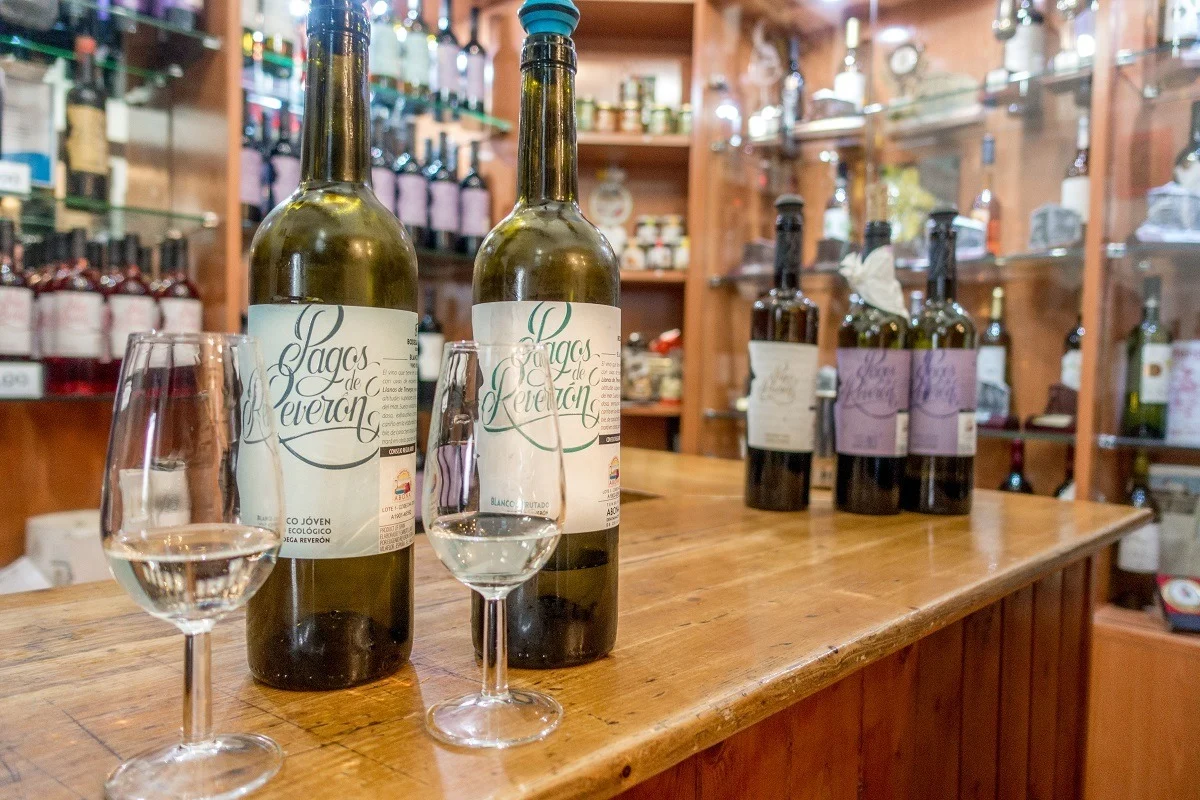
Visiting a Winery
The rich, volcanic soil on Tenerife’s volcano produces some very fine and very unusual wine varietals. We recommend visitors to Tenerife stop at the winery, Bodega Reveron. The winery is located on TF-51 between Vilaflor and Arona on your way down towards Los Christianos.
The Reveron winery produces a range of wines, but they excel at fine red wines. The grapes thrive in the hot Spanish sun on the wind-swept slopes of the Teide volcano. If you stop, you can follow in our footsteps: try their wines before buying a bottle to take back to your hotel or holiday rental apartment.
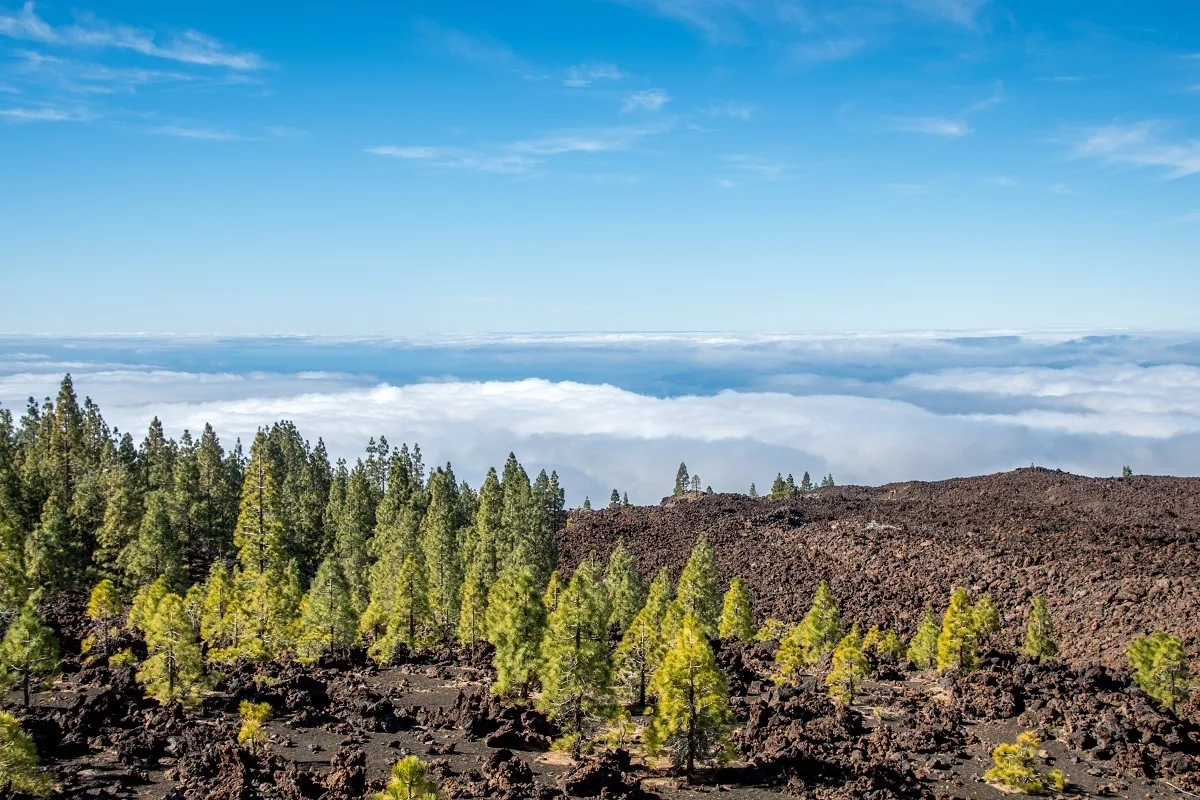
Top Tips for Visiting
Based on our experience, we put together these tips for visiting the Tenerife volcano:
Book Your Mount Teide Cable Car Tickets in Advance
There are two schools of thought on cable car tickets. The first is that you don’t want to be committed to a trip on a day when the weather may be bad. So, you don’t book tickets ahead and you just show up and buy your tickets that day. However, the downside to this strategy, is that tickets sometimes sell out or you may need to wait at the lower cable car station for a long period of time until lots of tour groups have gone (waits of over two hours are not uncommon, especially during peak season).
The second school of thought is to book your tickets for the Mt. Teide National Park cable car in advance. You can lock in a time, save money, and have certainty about your trip. The downside is that you might end up with tickets for a bad weather day.
So what should a visitor do about Teide tickets? Our recommendation is to book tickets in advance, however, we recommend waiting until 2-5 days before the date to do it. This way, you can check the forecast for the best weather on Mount Teide. You can check the Mount Teide weather forecast here.
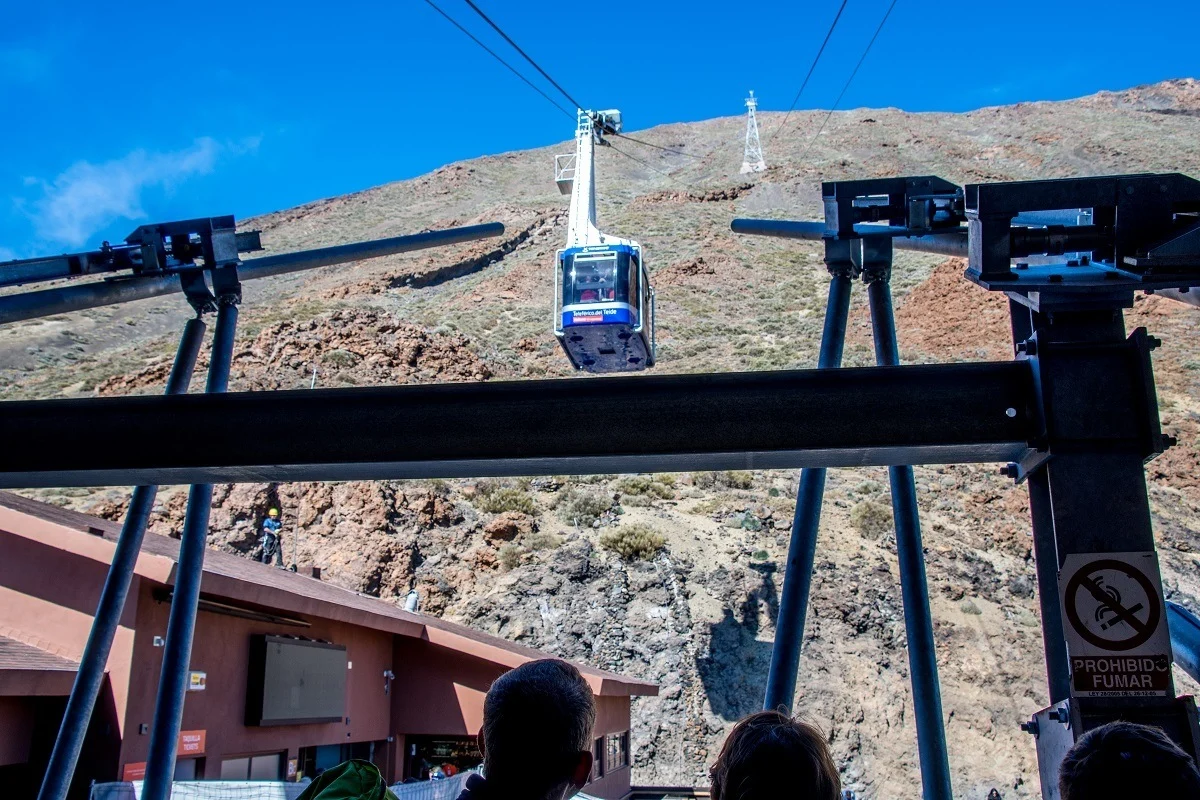
Mount Teide Summit Permit
If you want to hike to the summit of the volcano peak, you need a Mount Teide permit. You can apply for the Mount Teide Hiking Permit here. Permits go fast, so apply for your permit as far in advance as you can.
An alternative to the permit process is to book a cable car trip with guided tour, which includes the summit permit. Guided tours with summit permits can be booked here. Even if you are unsuccessful in getting a permit, visiting the volcano is still worth it!
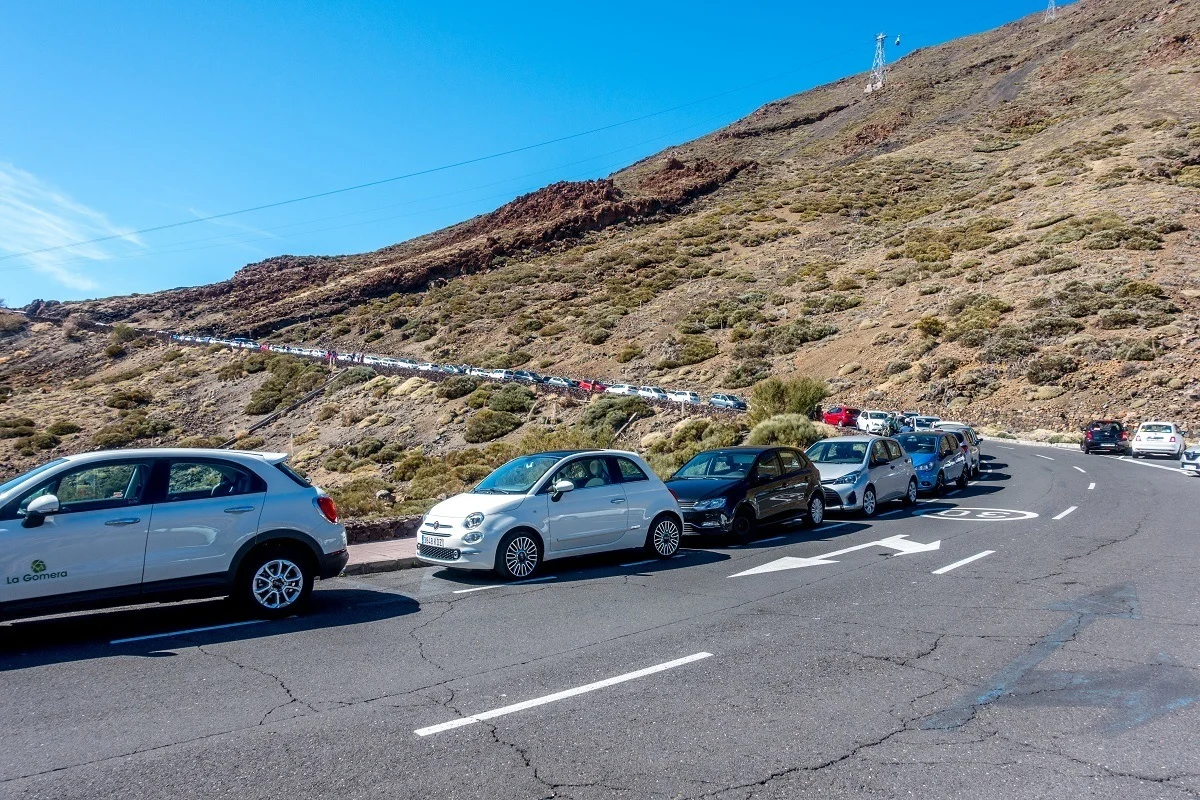
Mount Teide Parking
There is limited parking along the roads and in the parking lots at the cable car station (GPS location: 28.255055, -16.625664). In fact, there are only 220 parking spots. If you see a spot, grab it, and don’t count on another spot that might be closer. While there is parking along the road up to the cable car station, there can also be traffic jams as buses try to navigate the confined space. Consider parking at the bottom in one of the three carparks and walking up (GPS for the lower lot is 28.255016, -16.621633). It’s a 6-minute walk at a moderate pace.
The parking lots are busiest in the middle of the day. The people in the morning will be coming down and the people for the afternoon will be arriving. This means there is overlap and fewer spaces. Try to plan your arrival for early or later in the day to accommodate this. Do the math: the cable car runs every 8 minutes and holds 44 people, but there are only 220 parking spots. Parking spots go fast!
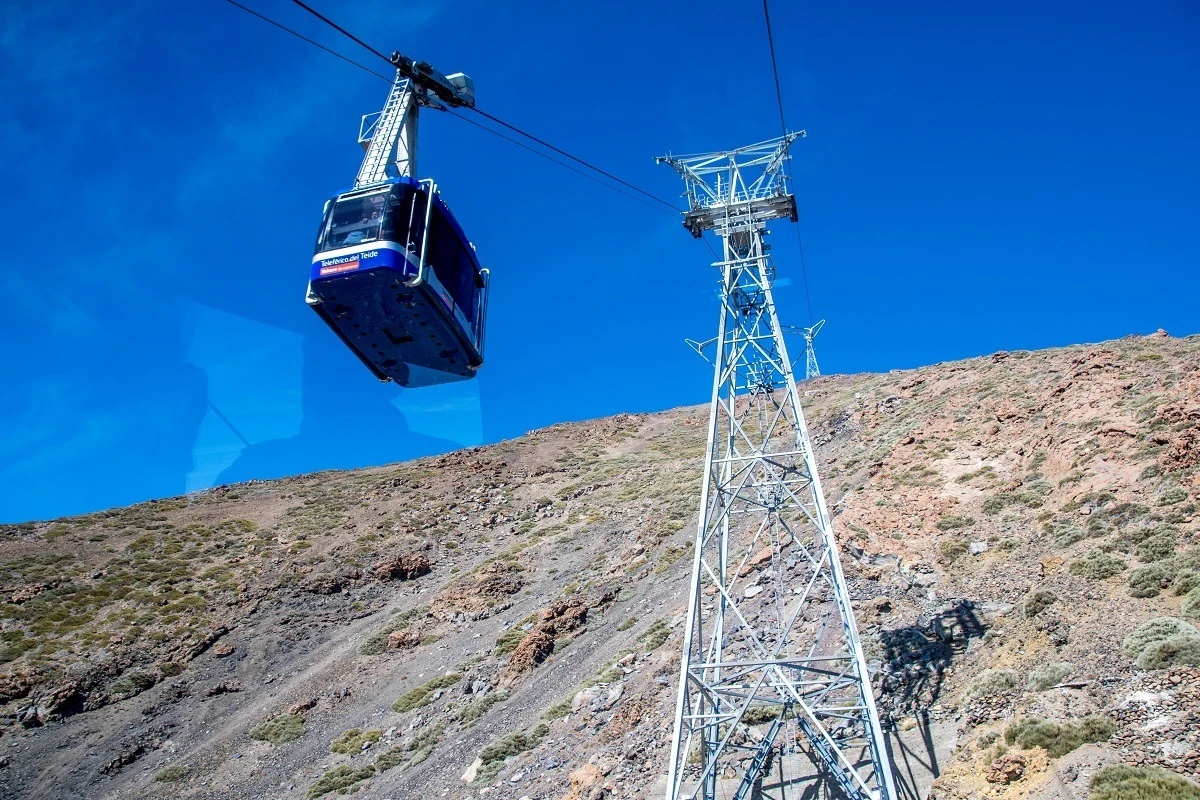
In the worst-case scenario, you can park for the cable car at the Parador de Cañadas del Teide hotel/visitors center. You should allow approximately 1 hour to walk from the Parador de Cañadas to the Mt. Teide cable car station (it is approximately 4.4 kilometers). It’s not an ideal solution, but you can do it if you have no other options. This means, you should plan to arrive at the cable car early in case you need to try and find parking.
Resist the temptation to just park illegally along the side of the road. The police patrol the area and tickets are common.

Mobile Phone Service
Mobile phone service on the mountain can be extremely poor. While we did find we had reception in several places, it was very sporadic. Visitors should not rely on mobile or cellular phone service for navigational purposes or GPS use.
Where to Stay While Visiting Mount Teide
You can either visit as a Teide day trip, or stay overnight on the volcano. If you want to stay overnight, there are two good options:
Altavista Mountain Refuge
This bunk house is located on the side of the volanco at an an elevation of over 3,260 meters. The views are absolutely fabulous, and the accommodations are absolutely basic. You’re getting a bunk bed in a communal dormitory. Guests need to arrive between 5:00pm-10:00pm and rooms are allotted at 7:00pm, which is perfect because it will give you a chance to catch the Mount Teide sunset. All guests need to leave by 7:30am, however, if you want to visit the summit for sunrise, you’ll need to leave by about 5:00am.
The Altavista Refuge has only 54 beds and these book far, far in advance. Because guests at the Altavista Refuge get access to the summit before 9:00am, you don’t actually need a permit to stay here. Guests will need to bring all of their own food, which can be cooked in the small kitchen. While this is a no frills option, the chance to visit the summit for sunrise make it worth it and and one of the best accommodations in Tenerife. Check reviews and book a room here.
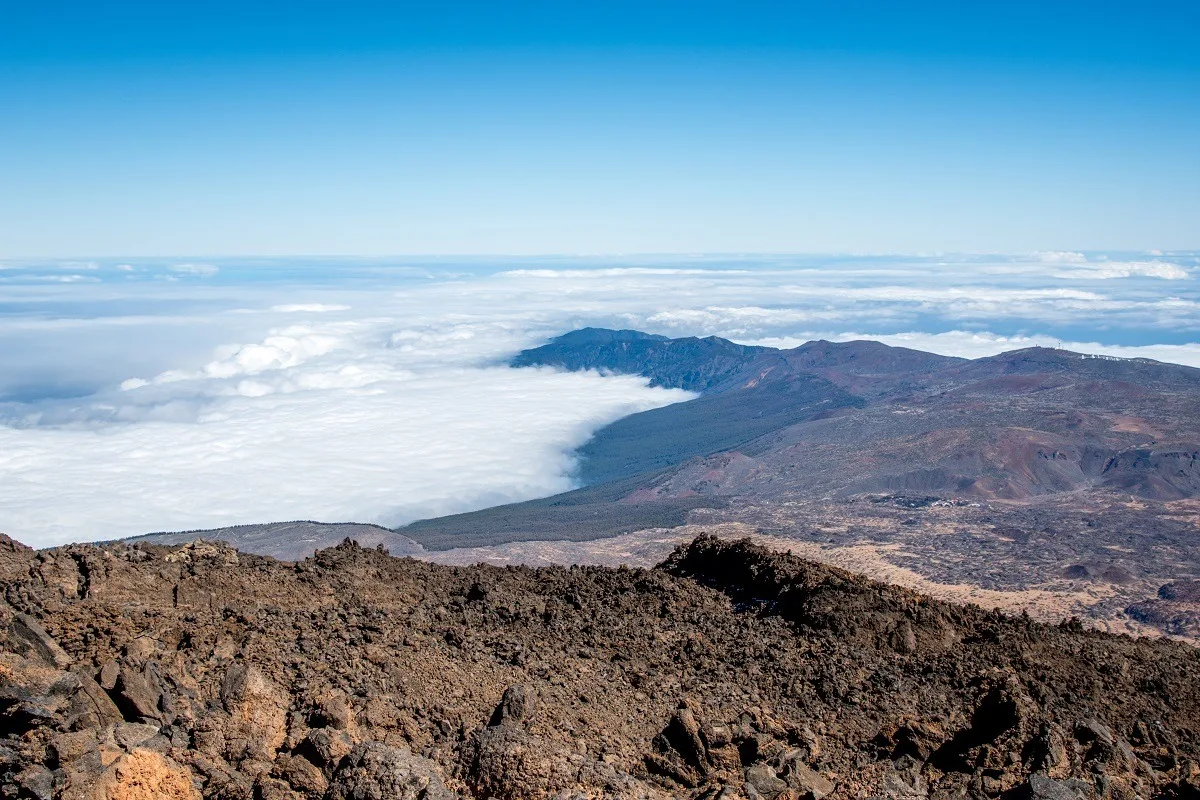
Parador de Las Cañadas del Teide
The Parador de Las Cañadas del Teide is the ideal choice to stay inside the national park and sleep on the volcano. This hotel offers exceptional views of the volcanic cone, caldera, and the breathtaking geography. The hotel has the nicest restaurant in the park and also a swimming pool. However, with a capacity for only 73 guests, rooms here book far in advance. Please note: guests at Parador de Las Cañadas del Teide do not get special access to El Teide mountain or a summit permit. Check reviews and book a room here.
If you want to visit the mountain as an excursion, you can stay anywhere else on Tenerife. The volcano is reachable from every point on Tenerife Island. However, our recommendation would be to stay somewhere on the southwest coast, like Costa Adeje. Check accommodation options in Adeje here.

Where to Eat on Mount Teide
Restaurante Papillon
Located in Portillo Alto about 10 minutes from the cable car, Restaurante Papillon is your best bet for food in Mount Teide National Park. Papillon lacks the large parking lot for the big buses, so it has a slightly more relaxed quality to it. They do get some buses, particularly in the evening, when the “Mount Teide by Night” tours stop here.
Restaurante La Bamby and Restaurant el Portillo
These two restaurants on Mount Teide are owned by the same management group and have the same menu. Restaurante La Bamby is located across the street from Papillon and Restaurante el Portillo is located a few kilometers down the road just past the Portillo visitor’s center. Both have large capacities (300+) and big parking lots catering to the motor coaches. However, they turn the food quickly. We ate at La Bamby were pleasantly surprised at the quality. They serve mostly Canarian cuisine, but have a few tapas and pintxos on the menu. It was not the best restaurant in Tenerife, however, it was better than we expected.
Restaurante Parador de Las Cañadas del Teide
The restaurant in the Parador de Las Cañadas del Teide is your best bet for fine dining and a refined meal on the mountain. Food is prepared by an actual chef and is up to the standards you’ll find at any resort. However, on the downside, you do get large tour bus groups and the restaurant hours leave something to be desired. The Parador de Las Cañadas del Teide closes for lunch at 15:30, which is quite early, particularly if you are going up the mountain.
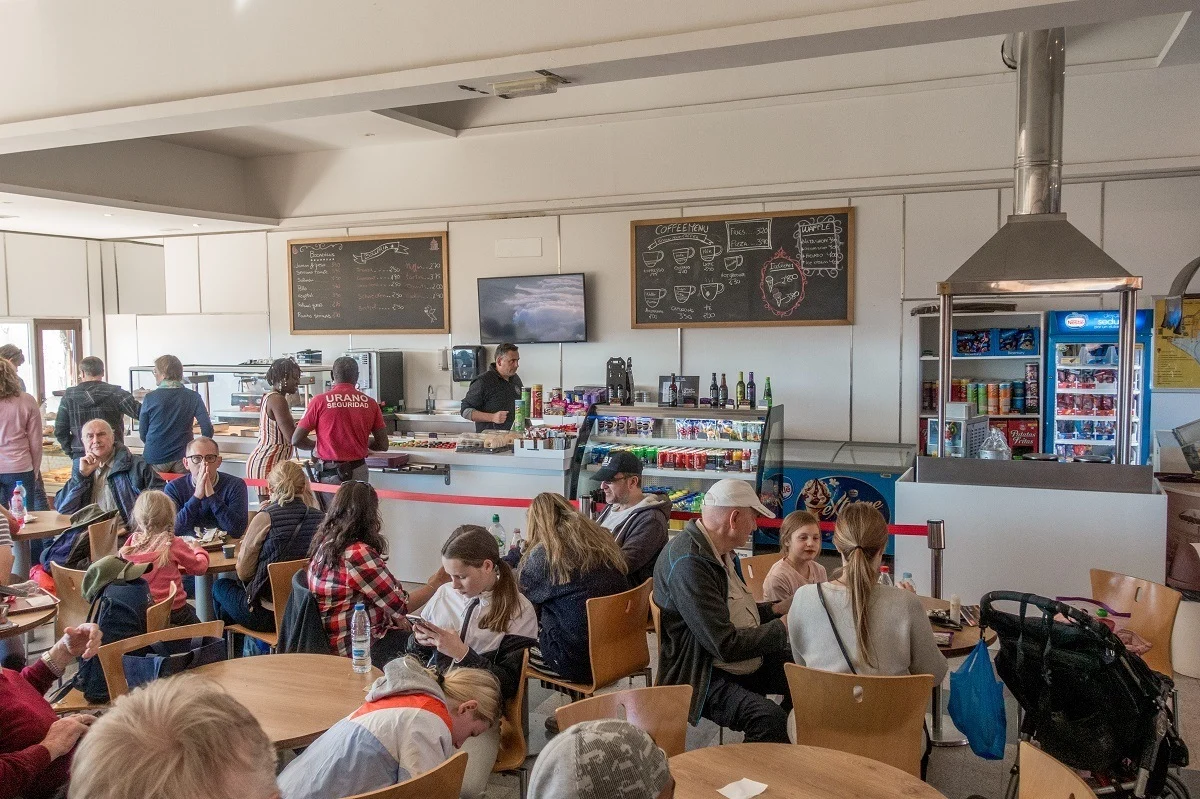
Cable Car Snack Kiosk and Buffet
The easiest and most uninspiring option is the snack kiosk and buffet at the lower cable car station. Options are both expensive and limited, although the ice cream is quite good!
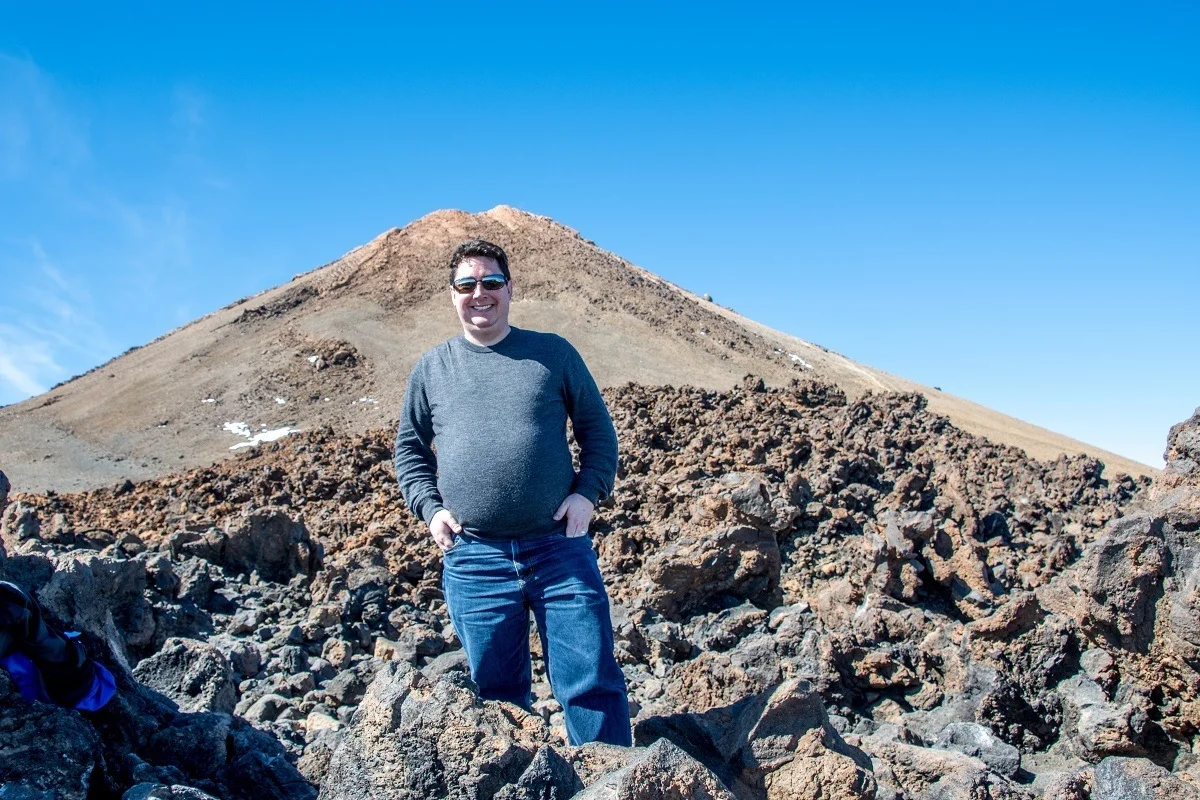
What to Bring on Your Trip
If you’re planning a trip, your experience will be greatly enhanced if you come prepared. We recommend bringing:
Camera: The views are second-to-none anywhere in the world. You’ll probably want to capture the moment with a good travel camera. We personally use the Sony RX 100 and the Nikon D-7500.
Hat, gloves, and warm clothes: It can get cold up on the summit, even in summer. Be sure to pack warm clothes and dress in layers. It seems strange to bring warm clothes to a best destination like Tenerife, but you’ll thank us!
Sunscreen and sunglasses: The sun can be very intense in Tenerife. Be sure to pack sunscreen! There is almost no shade up on the volcano, so be prepared.
Water bottle: You should bring a large water bottle for your trip. And if you plan on hiking the summit, you should bring a second water bottle. While the temperatures on the summit can be cool, you’ll be exerting lots of energy and you should stay hydrated.
Headlamp: If you are planning to climb up and stay at the Altavista Refuge, you will definitely need a headlamp. To experience sunrise on Mount Teide requires you to leave the refuge well before dawn.
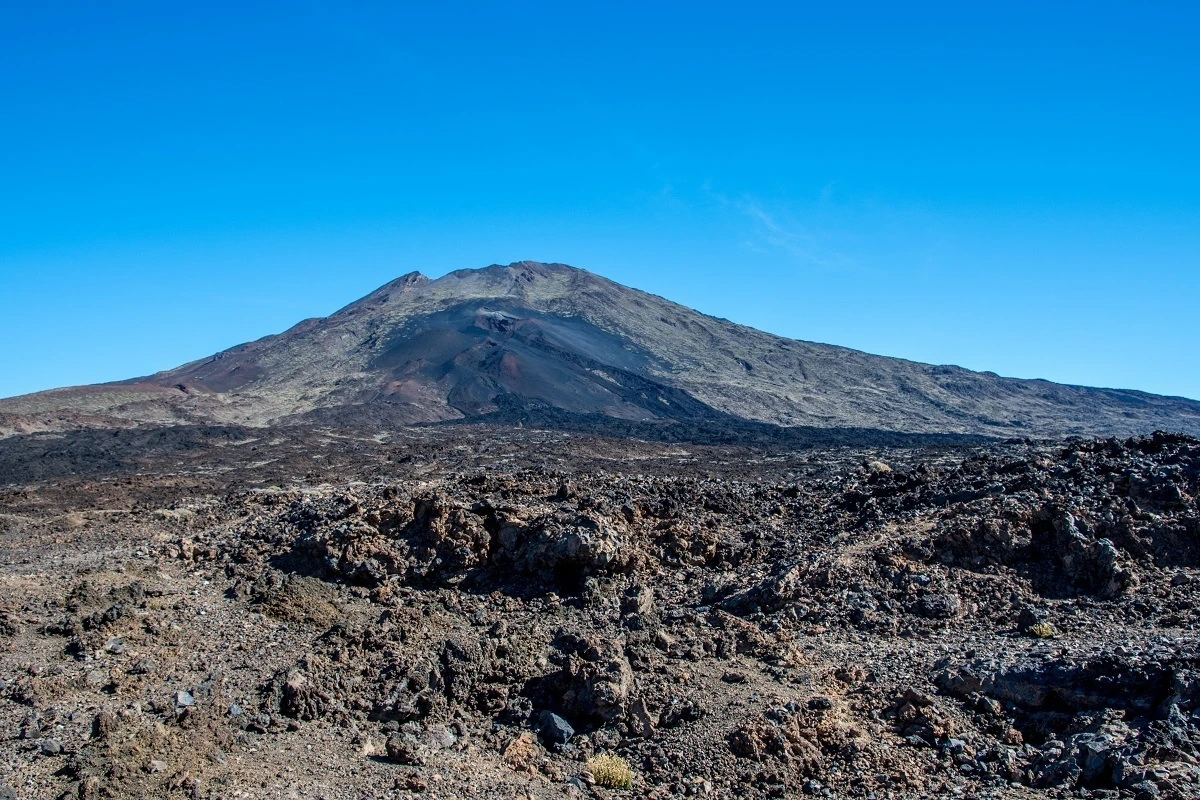
Frequently Asked Questions
Where is Mount Teide?
Mount Teide is the volcano on Tenerife, on the Canary Islands (part of Spain) in the Atlantic Ocean. The volcano is located on the southwestern half of the island.
How High is Mount Teide?
The height is 3,718 meters (12,198 feet), making it the highest mountain in Spain. A common trivia question is, ‘what is the highest mountain in Spain’ because many people don’t immediately associate the Canary Islands with Spain.
What is the Teide Shadow?
As one of the tallest mountains in the world (as measured from its base), the volcano casts the largest shadow in the world. The perfect triangular shadow is cast on the sea and partly covers the neighboring island of Gran Canaria. Sunset is the most popular time to visit the volcano to try and catch a glimpse of the shadow.
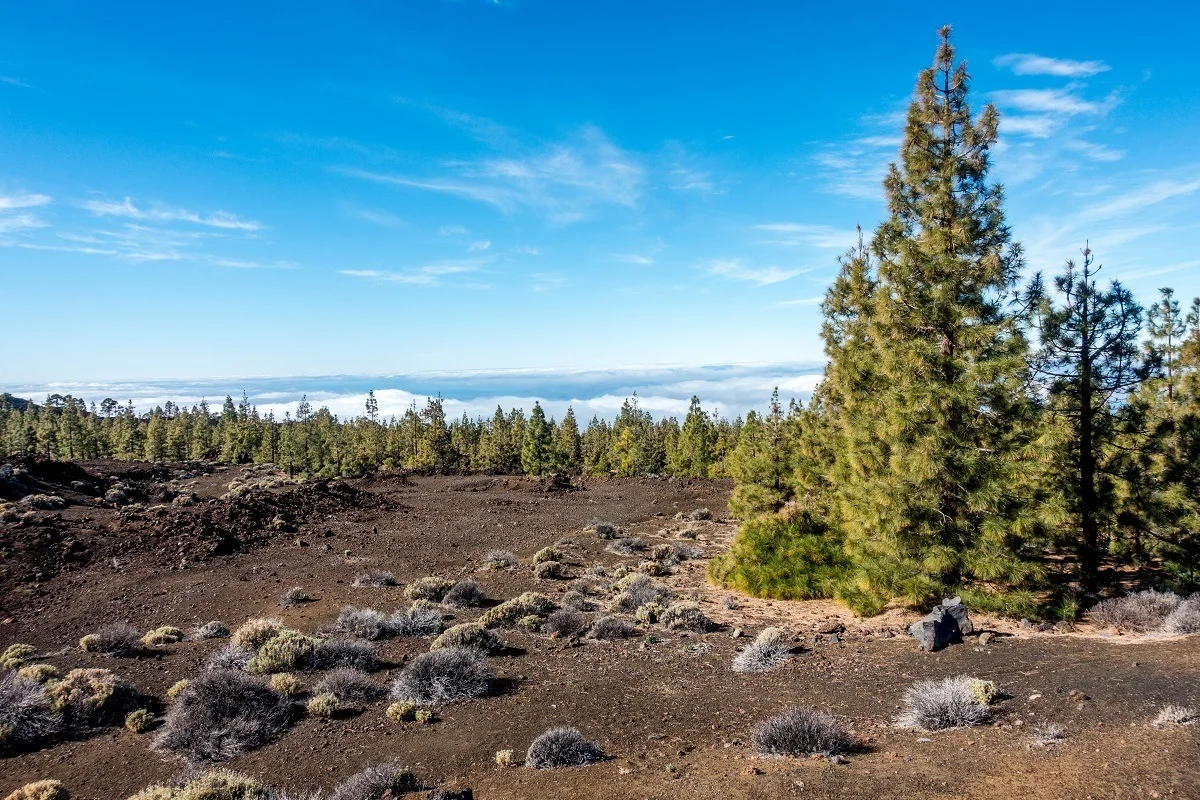
Is Mount Teide Active?
This is an active volcano, although the chances of seeing volcanic activity are very slim. The last eruption was in November 1909.
Is it About to Erupt?
For years, British tabloid magazines have been predicting an imminent eruption. And it hasn’t happened. Yes, there will be another eruption someday. It could be tomorrow or another 100 years from now. However, the chances of it happening on the exact day you visit are as close to zero as could possibly exist. And the next time a British tabloid predicts an imminent eruption, try to find someone to make a bet. The odds are in your favor.
Lance Longwell is a travel writer and photographer who has published Travel Addicts since 2008, making it one of the oldest travel blogs. He is a life-long traveler, having visited all 50 of the United States by the time he graduated high school. Lance has continued his adventures by visiting 70 countries on 5 continents – all in search of the world’s perfect sausage. He’s a passionate foodie and enjoys hot springs and cultural oddities. When he’s not traveling (or writing about travel), you’ll find him photographing his hometown of Philadelphia.

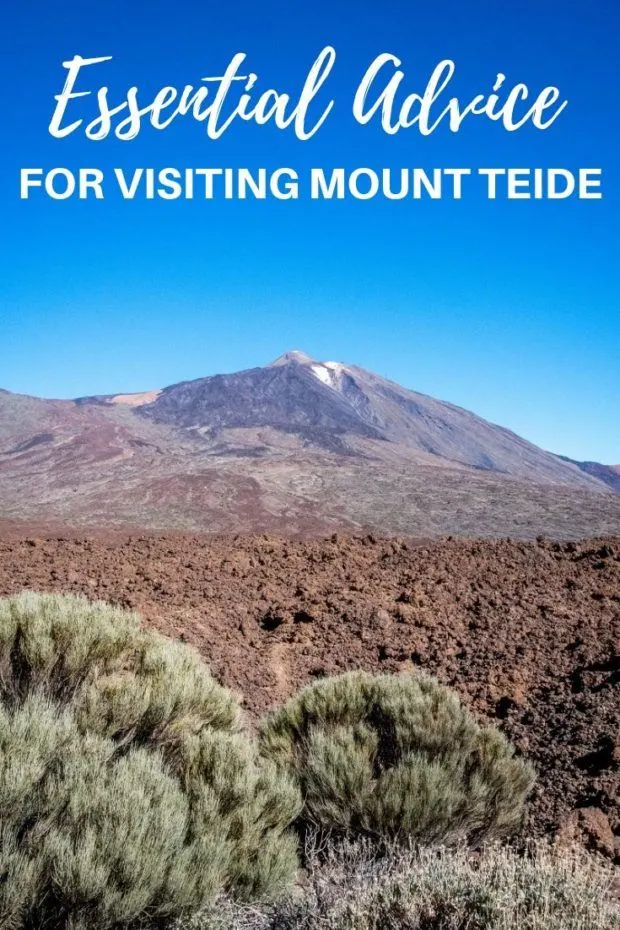
Betty
Wednesday 22nd of March 2023
Hi, I would like to know what is the best time of day to go to Mt, Teide? Thanks in advance.
Lance Longwell
Tuesday 4th of April 2023
Depends what your goals are. If you want cooler temperatures and fewer people, go first thing in the morning. However, if you want to see the famous Teide Shadow, you have to go at sunset.
Gareth Gosling
Saturday 20th of August 2022
Is it possible to get a What 3 Words location for the car park for the lower cable car station please?
Lance Longwell
Saturday 20th of August 2022
Updated with GPS coordinates. Nobody uses What3Words (and the company sues people who use/publish their proprietary information).
Nat
Monday 4th of April 2022
Hi, could I ask, do you know if it is possible to take public transport to the Cable Car Station and if so, where would be the best place to take it from (and stay the night before). TIA
Lance Longwell
Monday 4th of April 2022
It's possible, but not recommended. The local bus in Tenerife is called the guagua. You can take bus number 348 from Puerto de la Cruz. Or, you can take bus number 342 from Costa Adeje. But the buses are notoriously unreliable and don't really run on a schedule.
Lars Salquist
Monday 17th of January 2022
Hi, Great homepage. If you go up by cable car, how long is the trip back if you go by foot? Best, Lars
Lance Longwell
Tuesday 18th of January 2022
The hike up is 5-6 hours. The hike back down can be done in as little as 2-3 hours, but most hikers will allow about 4 hours.
Nicole
Thursday 22nd of July 2021
Thank you so much for all the information about Mt. Teide. It is difficult to find all this helpful information.